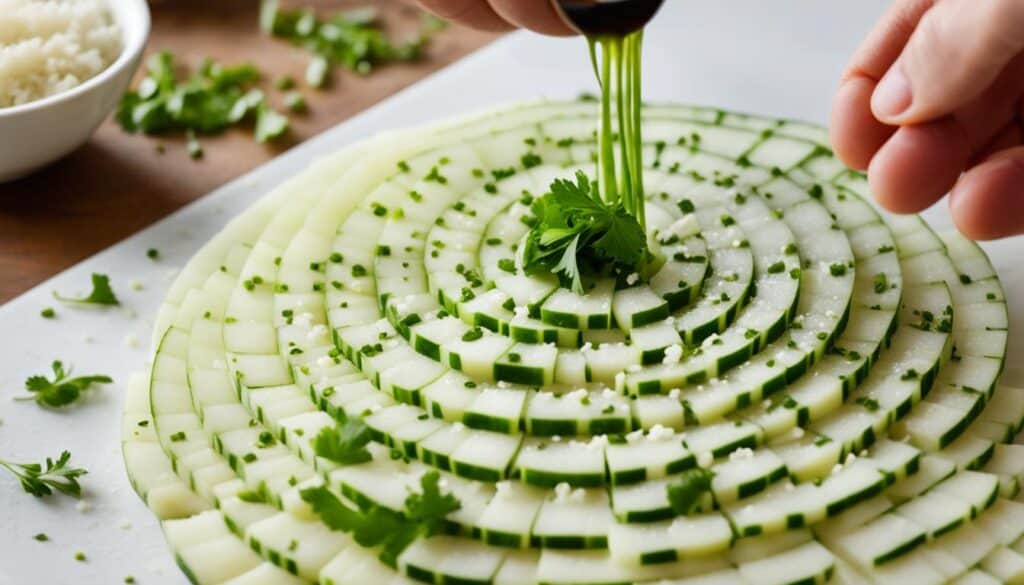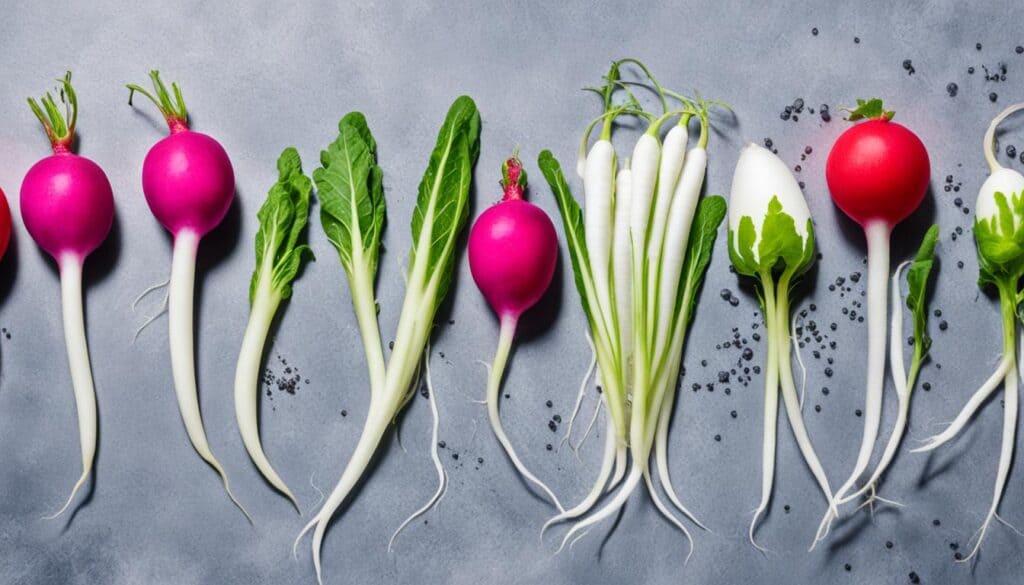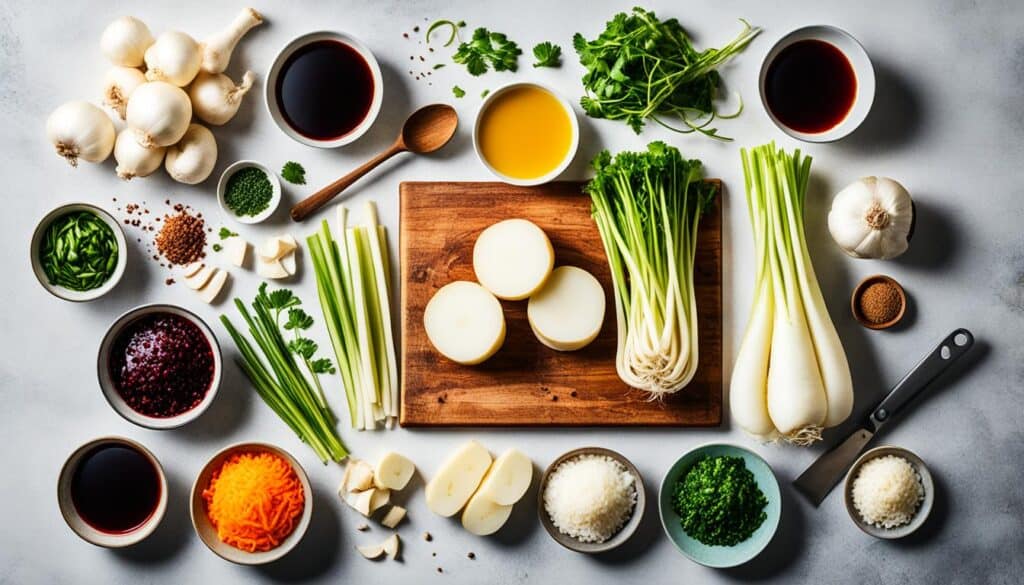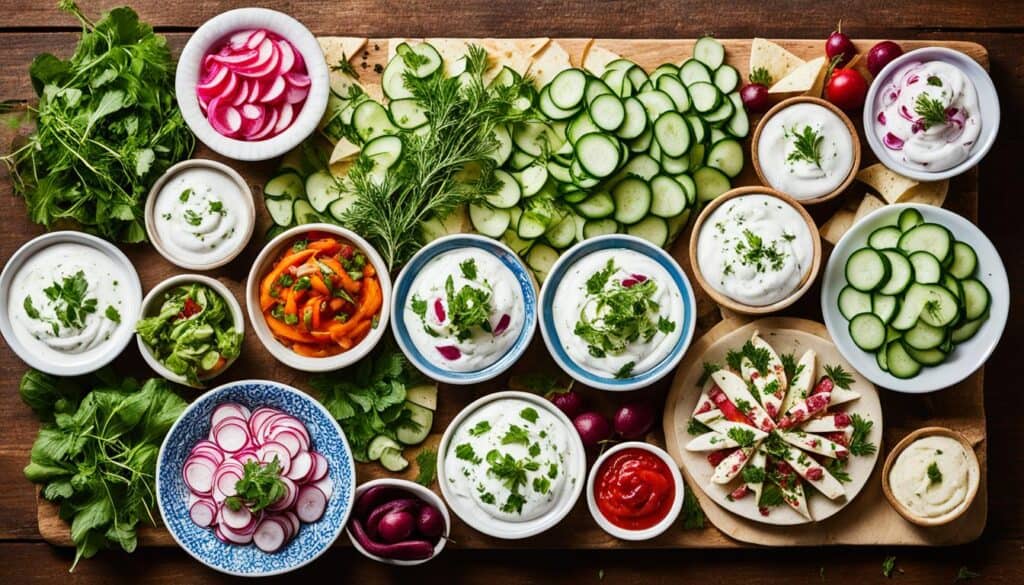Did you know that mooli radish, also known as Raphanus sativus L., is a powerhouse of nutrition? This humble root vegetable is not only low in calories, but it also packs a punch when it comes to providing essential nutrients. From protein and fiber to vitamins and minerals, mooli radish offers a wide range of health benefits that you may not be aware of.
Key Takeaways:
- Mooli radish is a nutrient-dense vegetable that is low in calories but high in essential nutrients.
- It contains protein, dietary fiber, calcium, potassium, and vitamins like vitamin C and vitamin K.
- Mooli radish offers potential health benefits such as lowering blood pressure, protecting the heart, and potentially reducing the risk of cancer.
- You can enjoy mooli radish in various forms, including raw in salads, cooked in curries, or processed as pickles.
- Consult with a healthcare professional before using mooli radish for medicinal purposes or making significant changes to your diet.
Nutritional Value of Mooli Radish
Mooli radish, also known as daikon radish, is not only delicious but also packed with essential nutrients. Let’s take a closer look at the nutritional value of this versatile vegetable.
Vitamins and Minerals
Mooli radish is a rich source of several vitamins and minerals, including:
| Nutrient | Amount per 100g |
|---|---|
| Calcium | 27mg |
| Potassium | 233mg |
| Vitamin C | 27.4mg |
| Vitamin K | 1.6mcg |
| Magnesium | 9mg |
| Phosphorus | 25mg |
| Iron | 0.34mg |
| Zinc | 0.28mg |
| Vitamin B6 | 0.036mg |
These nutrients are essential for various bodily functions, including bone health, immune system support, and energy production.
Macronutrients
Per 100g serving, mooli radish provides:
- Calories: 18
- Protein: 0.9g
- Fat: 0.1g
- Carbohydrates: 4.1g
- Dietary Fiber: 1.6g
These macronutrients contribute to the energy and fiber content of mooli radish, making it a nutritious addition to your diet.
Health Benefits
With its impressive nutritional profile, mooli radish provides several health benefits. Its high vitamin C content supports immune function and collagen production, while vitamin K plays a crucial role in blood clotting and bone health. Additionally, the rich potassium content helps regulate blood pressure and maintains proper heart function.
Mooli radish contains antioxidants and bioactive compounds that may have anti-inflammatory and anticancer properties, aiding in the prevention of chronic diseases.
Moreover, the dietary fiber in mooli radish promotes digestive health, aids in weight management, and helps regulate blood sugar levels.
Now that you’re aware of the impressive nutritional benefits of mooli radish, consider adding it to your regular diet to enjoy its unique taste and boost your overall health.
Health Benefits of Mooli Radish
Mooli radish, with its rich nutritional profile and bioactive compounds, offers a range of potential health benefits. Here are some of them:
1. Lowering Blood Pressure:
The potassium content in mooli radish may help regulate blood pressure levels, contributing to cardiovascular health.
2. Reducing the Risk of Heart Disease:
Research suggests that mooli radish’s antioxidants and dietary fiber may help prevent heart disease by reducing cholesterol levels and improving heart health.
3. Antimicrobial Properties:
The antimicrobial properties of mooli radish may help combat certain bacterial infections and promote overall immune health.
4. Antioxidant Activity:
The presence of antioxidants in mooli radish, such as vitamin C and certain bioactive compounds, may help fight oxidative stress and protect cells from damage.
5. Potential Cancer Prevention:
Some studies have shown that mooli radish’s bioactive compounds may inhibit the growth of cancer cells, potentially reducing the risk of certain types of cancer.
6. Support for Liver Health:
Mooli radish contains compounds that may support liver health by promoting detoxification processes and maintaining optimal liver function.
7. Anxiety-Reducing Potential:
Early research suggests that certain compounds in mooli radish may have anxiety-reducing properties, contributing to overall mental well-being.
Please note that these health benefits are based on preliminary research and further studies are needed to confirm their effectiveness in humans. It is always recommended to consult with a healthcare professional before making any significant dietary changes or starting any herbal remedies.
Stay tuned for the next section, where I’ll share some valuable cooking tips for mooli radish!
Cooking Tips for Mooli Radish
When it comes to cooking mooli radish, the possibilities are endless. Whether you prefer it raw or cooked, there are several delicious ways to incorporate this versatile vegetable into your meals.
Raw mooli radish can add a crisp and refreshing crunch to salads. Simply peel and slice the radish into thin rounds or matchsticks, and toss them with your favorite greens, dressing, and toppings. The mild spiciness of the mooli radish adds a delightful kick to the salad, balancing the flavors perfectly.
If you enjoy cooked dishes, mooli radish can be a fantastic addition to curries and stir-fries. Cut the radish into bite-sized pieces and sauté them with other vegetables and spices of your choice. The radish softens and absorbs the flavors of the dish, creating a delicious and hearty meal.
Processed mooli radish roots are commonly used in dried or canned pickles. These pickles make a tangy and savory accompaniment to various dishes. They add a burst of flavor and can be enjoyed as a side or condiment.
Get creative with mooli radish by blending it into smoothies. Pair it with other vegetables or fruits for a refreshing and nutritious drink. The natural sweetness of the mooli radish adds depth to the smoothie while providing essential vitamins and minerals.
Enjoying Radish Greens
Don’t forget about the radish greens! They are entirely edible and packed with nutrition. Radish greens can be sautéed as a tasty side dish or added to salads for an extra boost of freshness. They can also be used in soups, stews, or pesto sauce for added flavor and texture.
A Quick and Easy Mooli Radish Salad Recipe:
Ingredients:
- 2 mooli radishes, peeled and thinly sliced
- 1 cup mixed salad greens
- 1/4 cup cherry tomatoes, halved
- 2 tablespoons lemon juice
- 1 tablespoon olive oil
- Salt and pepper to taste
Instructions:
- In a large bowl, combine the sliced mooli radishes, mixed salad greens, and cherry tomatoes.
- In a separate small bowl, whisk together the lemon juice, olive oil, salt, and pepper.
- Pour the dressing over the salad mixture and toss gently to coat.
- Let the flavors meld for a few minutes before serving.
No matter how you choose to prepare mooli radish, be sure to consult recipes and cooking techniques to fully enjoy its unique flavor and texture. Now, let’s explore different types of radish in the next section.
Different Types of Radish
Radishes come in various types, each with its own characteristics and flavors. Exploring the different types of radish can add variety and flavor to your culinary experiences. Some common types include:
- Red Radishes: These radishes are round with red skin and crisp, white flesh. They have a spicy and slightly peppery flavor.
- Daikon Radishes: Originating from Japan and China, daikon radishes have white or green flesh and a milder flavor compared to red radishes. They are often used in soups, stir-fries, and pickles.
- Watermelon Radishes: With their vibrant white and green skin and stunning magenta flesh, watermelon radishes have a mild and slightly sweet flavor.
- Black Radishes: These radishes have rough, jet-black skin and crisp, white flesh. They have a sharp and earthy flavor.
- French Breakfast Radishes: This variety is elongated and has a red top blending into a white bottom. French breakfast radishes have a mild flavor and are often enjoyed with butter and salt.
- Easter Egg Radishes: These radishes come in a variety of colors, such as pink, purple, and white. They have a mild and subtly sweet flavor.
- Sakurajima Daikon: Known for its large size, the Sakurajima daikon radish is native to Japan. It has a mild flavor and is often used in both raw and cooked dishes.
Here’s a visual representation of the different types of radish:
| Type | Description |
|---|---|
| Various types of radish with descriptions |
Safety Precautions and Side Effects
While mooli radish is considered safe and offers numerous health benefits, it’s important to be aware of some precautions and potential side effects associated with its consumption.
Allergies
Allergies to radishes are rare, but in some individuals, they can cause symptoms such as itching and swollen lips. If you experience any allergic reactions after consuming mooli radish, it’s recommended to avoid further consumption and consult with a healthcare professional.
Potential Dehydration
Mooli radish has natural diuretic properties, meaning it can increase urine production and potentially lead to dehydration if consumed excessively. It’s important to stay adequately hydrated, especially if you consume significant amounts of mooli radish or have any underlying health conditions.
Stomach Irritation
In some individuals, consuming radish leaves, which are edible and nutritious, may cause stomach irritation. If you experience any discomfort or digestive issues, it’s advisable to limit or avoid consuming radish leaves and consult with a healthcare professional if necessary.
Potential Blood Pressure Reduction
Mooli radish has been associated with blood pressure-lowering effects. While this can be beneficial for individuals with high blood pressure, those with low blood pressure should exercise caution when consuming mooli radish to avoid further lowering their blood pressure levels. It’s recommended to consult with a healthcare professional, especially if you have any underlying medical conditions.
Always remember to consult with a healthcare professional before making significant changes to your diet or incorporating mooli radish into your daily routine, especially if you have any existing medical conditions or are taking medications.
| Precautions and Side Effects | Recommendations |
|---|---|
| Allergies | Avoid further consumption and consult with a healthcare professional if allergic reactions occur. |
| Potential Dehydration | Stay adequately hydrated, especially when consuming significant amounts of mooli radish. |
| Stomach Irritation | Limit or avoid consuming radish leaves if you experience stomach irritation. Consult with a healthcare professional if necessary. |
| Potential Blood Pressure Reduction | Exercise caution if you have low blood pressure. Consult with a healthcare professional for personalized advice. |
Cooking Tips for Daikon Radish
Daikon radish, also known as mooli radish, is a versatile vegetable that can be cooked in various ways. Its mild and slightly sweet flavor adds a unique touch to dishes from different cuisines. Here are some cooking tips to help you make the most of daikon radish in your meals:
1. Slicing for Salads
If you prefer a refreshing and crunchy taste, slice daikon radish into thin rounds or matchsticks and add them to salads. The crisp texture and subtle flavor of daikon radish can complement a variety of salad ingredients.
2. Cooking in Curries and Stir-fries
Daikon radish can be a great addition to curries, stir-fries, and other cooked dishes. Cut daikon radish into bite-sized pieces or slices and cook them along with other vegetables, meat, or tofu. The mild flavor of daikon radish absorbs the flavors of the dish, making it a delicious and nutritious ingredient.
3. Pickling
Another way to enjoy daikon radish is by pickling it. Cut daikon radish into thin strips or rounds and place them in a jar with vinegar, salt, and other seasonings like ginger or chili flakes. Let the daikon radish pickle in the refrigerator for a few hours or overnight to enhance its tangy flavor and crisp texture.
4. Soup and Noodle Broths
Daikon radish can add depth and flavor to soup and noodle broths. Cut daikon radish into chunks or julienne strips and simmer them along with other ingredients to infuse the broth with its subtle sweetness. The cooked daikon radish adds a satisfying texture to soups and noodle dishes.
5. Roasting
If you prefer a caramelized and slightly sweet flavor, try roasting daikon radish. Cut daikon radish into wedges or slices, toss them with olive oil, salt, and your favorite spices, and roast them in the oven until tender and golden. The roasted daikon radish can be enjoyed as a tasty side dish or added to grain bowls and roasted vegetable medleys.
Tip: Daikon radish pairs well with flavors like soy sauce, ginger, garlic, sesame oil, and green onions. Experiment with different seasonings and cooking methods to discover your favorite way to cook daikon radish.
Remember, daikon radish is a versatile vegetable that can be enjoyed in both raw and cooked forms. Its versatility and mild flavor make it a wonderful addition to various cuisines, allowing you to explore new recipes and culinary styles. Let your creativity guide you as you discover the delicious and nutritious possibilities of daikon radish in your kitchen.
| Benefits | Nutrition |
|---|---|
| • Adds a refreshing crunch to salads | • Low in calories • High in dietary fiber • Good source of vitamin C and potassium |
| • Enhances the flavor of curries and stir-fries | |
| • Provides a tangy and crisp pickle option | |
| • Adds depth to soup and noodle broths | • Contributes to a well-rounded, nutritious diet |
| • Caramelizes beautifully when roasted | • Supports healthy digestion |
Mooli Radish in Different Cuisines
Mooli radish, with its versatile flavor and culinary versatility, is widely incorporated into various cuisines across the globe. Its unique taste and texture make it a popular ingredient in both Asian and Western cooking.
Asian Cuisine
In Asian cuisine, mooli radish is a staple ingredient used in a variety of dishes. It is commonly featured in stir-fries, curries, pickles, and soups. The mild and slightly spicy flavor of mooli radish adds depth and complexity to these traditional Asian recipes.
Western Cuisine
In Western cuisine, mooli radish can be used in a wide array of ways. It can be sliced and added to salads, bringing a refreshing and crunchy element to the dish. Mooli radish can also be used as a substitute for more traditional radishes in recipes like sandwiches or wraps. Additionally, roasting or sautéing mooli radish can create a unique and flavorful side dish that pairs well with various main courses.
Exploring the diverse use of mooli radish in different cuisines can spark inspiration and enable you to create innovative and exciting dishes in your own kitchen.
| Asian Cuisine | Western Cuisine |
|---|---|
| Stir-fries | Sliced in salads |
| Curries | Substitute for traditional radishes |
| Pickles | Roasted or sautéed as a side dish |
| Soups |
Potential Cultural Significance of Mooli Radish
In various countries and traditional medicine practices, mooli radish holds cultural significance. In Asian cultures like India, mooli radish has long been used in traditional Ayurvedic and herbal remedies for a wide array of health conditions. The radish is believed to possess cleansing and detoxifying properties, making it valuable in promoting overall well-being. Furthermore, mooli radish is utilized in traditional dishes and festivals, symbolizing prosperity and good luck. Delving into the cultural significance of mooli radish can deepen one’s understanding and appreciation for the vegetable’s value within different traditions.
| Cultural Significance of Mooli Radish | Country/Region |
|---|---|
| Ayurvedic and herbal remedy | India |
| Symbol of prosperity and good luck | Various Asian cultures and festivals |
Conclusion
After exploring the world of mooli radish, it’s clear that this versatile vegetable has much to offer. With its rich nutrition profile, packed with minerals, vitamins, and antioxidants, mooli radish can be a valuable addition to any diet. Whether enjoyed raw in salads or cooked in curries and pickles, it brings a unique flavor and texture to your meals.
However, it’s important to remember that mooli radish is just one piece of the puzzle. For optimal health, it’s crucial to maintain a balanced and varied diet, incorporating a wide range of nutrient-rich foods. Consulting with a healthcare professional can provide personalized guidance and ensure that mooli radish fits seamlessly into your overall dietary plan.
With its potential health benefits and culinary versatility, mooli radish is a fantastic ingredient to experiment with in your kitchen. Try incorporating it into your favorite recipes or explore new mooli radish recipes to add excitement and nourishment to your meals. Whether you’re looking to boost your nutrient intake or simply add some flair to your dishes, mooli radish is a wonderful choice.










Leave a Reply